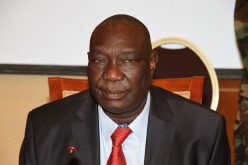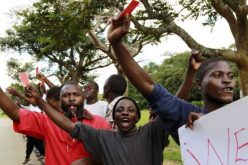 Starrfmonline.com – Dr Mahamudu Bawumia, the Running Mate to the main opposition New Patriotic Party’s flagbearer has said he never lied to Ghanaians about the figures he churned out at a recent lecture concerning a Ghc918-million bailout package Ghana got from the International Monetary Fund (IMF).
Starrfmonline.com – Dr Mahamudu Bawumia, the Running Mate to the main opposition New Patriotic Party’s flagbearer has said he never lied to Ghanaians about the figures he churned out at a recent lecture concerning a Ghc918-million bailout package Ghana got from the International Monetary Fund (IMF).
The former Deputy Governor of the Bank of Ghana told Portia Asare of the African Christian Network in New York, on the sidelines of a fundraising dinner that people make such “blanket” statements “when they don’t have anything to say.”
“I gave a talk: 70-paged paper, and quite well researched and well documented so [I’m] quite comfortable, and in fact I don’t even understand what can be misleading.
“The question was: ‘Will the IMF anchor hold?’ I said this is why we got into the IMF: You were spending too much relative to revenues, which is true; You were borrowing too much, which is true; your external payment position has deteriorated, which is true; your growth is reducing, which is true; so You ended up at the IMF and the IMF will impose certain conditions, which is true; and if you don’t do certain things right, the anchor will not hold, which is true.
“So I’m not quite sure what it is that is not true that I said, but I think the supporters of this government and this government itself are reluctant to admit the truth even when it hits them in the face,” Dr Bawumia told the TV network.
Dr Bawumia’s defence of his facts and figures about Ghana’s economy comes on the heels of accusations against him by Government officials that he used the lecture for propaganda and politics.
Just a day after the lecture, Deputy Finance Minister Mona Quartey told Morning Stare’s Kafui Dey on Starr 103.5FM that most of the figures churned out by the three-time Running Mate to Nana Akufo-Addo at the lecture at the Central University College (CUC) were inaccurate.
“I think his numbers are not accurate because of course he is not working in the system and these are numbers that are being leaked to him and it will be difficult for him to verify unless he comes to speak to us, which is not a bad idea at all.
“We have the numbers and we can speak to the numbers,” Mrs Quartey said.
Dr Bawumia said at the lecture that the anchor being sought from the Fund for Ghana’s economy will not hold because the data upon which the programme is built is not credible.
According to the Economist, there are inconsistencies with the two main sets of data on inflation and GDP based on which the IMF bailout package was fashioned.
“Mr. Chairman any economic and financial programme is only as good as the data used to formulate the programme. Credible data provides the basis of the analytical framework to respond adequately to economic challenges. If you have make-believe data you will end up with counterproductive or inadequate responses to economic policies. If your data is not credible, the anchor cannot hold. With make-believe data as the basis, the best you can achieve is make-believe results which will soon be exposed as we are witnessing currently,” he said.
Dr. Bawumia explained that the inflation data on which the programme was drafted had question marks on it.
“Mr. Chairman, the data on inflation produced by the [Ghana Statistical Service] GSS does not appear to reflect actual price developments. I have raised this issue before and I have returned to it today with further and better particulars. The year 2014 was a very bad one as far as the economy is concerned.
“The exchange rate depreciated by 31%, utility and petroleum prices went up significantly and economic growth declined but for some reason inflation, especially food price inflation remained relatively subdued according to the Ghana Statistical Service. Between January and December 2014, the rate of increase in food prices as reported by the GSS actually declined marginally from 7.1% in January to 6.8% by December.
“Non-food prices on the other hand increased from 18.9% to 23.9% over the same period. Overall inflation increased from 13.8% to 17% on account of the decline in food price inflation. Clearly, the supposed low rates and even decline in food price inflation accounted for the relatively low inflation figures reported by the GSS,” he noted.
Dr. Bawumia, who doubles as a Visiting Professor at the Central University College explained that the evidence on the ground, did not appear to corroborate the food price inflation being churned out by the GSS and pointed out that since 2009, the normal relationship between food and non-food inflation seemed to no longer exist.
“Mr. Chairman, the decline in food price inflation is a curious phenomenon worthy of further investigation because it defies evidence that suggests otherwise. Most people one has talked to cannot believe that food price inflation has declined. Market survey reports by Joy FM news (under the heading “food prices killing Ghanaians” as well as the Finder newspaper (under the heading “70% hike in food prices in just one year”) indicate very high increases in food prices.
“Mr. Chairman, one can observe a structural break in the relationship between food and non-food inflation since 2009. Between 2001 and 2008, the relationship was much closer. Why did the relationship start to drift apart and even move in opposite directions? Was there a deliberate attempt to keep inflation down by fixing low food price inflation?”
The three-time Running Mate proceeded to reveal that contrary to expectations, the Ministry of Food and Agriculture, which collects the same data on food price inflation, had totally different estimates which appeared to be more realistic than the GSS Data.
“To conclusively challenge the GSS estimates, however, one needs independent data for the individual food items in Consumer Price Index over the period. Thankfully, such data exists and has been collected by the Ministry of Food and Agriculture (MOFA) across all ten regions of the country and published by the Statistics Research and Information Directorate of MOFA.
“Mr. Chairman, since the data was collected for the same commodities, and over the same period across the country, one would expect a close relationship between the two sets of price data, especially since these are both government/state sources. Thus if we even decide to ignore all the experiences of the market women and others, who complain of sharp rises in food prices, we expect that at least, the figures of the Ministry of Food and Agriculture, should to a large extent corroborate the figures of the Ghana Statistical Service.
“However, a comparison of the MOFA and GSS (both official sources) estimates of food price inflation overall and across specific food items shows very divergent estimates.”
On the composite food price inflation data, Dr. Bawumia stated: “While the MOFA estimated an increase in overall food price inflation from 0.7% in January to 26% by December 2014, GSS on the other hand estimated a decline in food price inflation from 5.7% in January to 2.8% by December 2014.”
Going into specific food items, he noted: “For 2014, while the MOFA estimated an increase in yam price inflation from 0.6% in January to 8.4% by December 2014, GSS on the other hand estimated a decline in yam price inflation from 3.4% in January to -1.8% by December 2014. Again, while the MOFA estimated an increase in rice price inflation from -2.3% in January to 5.2% by December 2014, GSS on the other hand estimated a decline in rice price inflation from 4.3% in January to -11.6% by December 2014 and that for 2014, while the MOFA estimated an increase in groundnut price inflation from 7.8% in January to 43.2% by December 2014, GSS on the other hand estimated a decline in groundnut price inflation from 5.9% in January to -2.98% by December 2014.”
Dr. Bawumia further touched on the differences in the data on price inflation for oranges, maize and smoked herrings.
“For 2014, while the MOFA estimated an increase in oranges price inflation from 6.8% in January to 46% by December 2014, GSS on the other hand estimated a decline in oranges price inflation from 9.9% in January to 4.9% by December 2014. MOFA estimated an increase in maize price inflation from 3.5% in January to 48% by December 2014, GSS on the other hand estimated a decline in maize price inflation from 4.8% in January to -2.3% by December 2014. Again, for 2014, while the MOFA estimated an increase in smoked herring price inflation from -0.4% in January to 35% by December 2014, GSS on the other hand estimated an increase in smoked herring price inflation from 4.7% in January to 12.7% by December 2014,” he stated.
Dr. Bawumia also touched on the GDP figures which he said could not be relied upon. “When the 2015 budget was announced, I had the opportunity to point out that the purported growth of real GDP by 6.9% in 2014 was not credible. How can an economy which went through so much turmoil in 2014, with a 31% depreciation of the currency and massive load shedding register real GDP growth of 6.9% only to decline sharply to 3.9% in 2015 when the government claims the economy is in recovery? The Ghana Statistical Service (GSS) subsequently revised the real GDP numbers. These revised numbers are however still very problematic and the Ghana Institute for Fiscal Studies (IFS) has recently pointed out these anomalies.”
“The revised GDP 2014 estimates shows growth rates of non-oil GDP at 2006 constant prices. The data contains some curious data. How can agriculture grow at 7.2%, industry at 4.5% and services at 5.6%, but then overall GDP at basic prices grows at 2.2%?” he queried.
Dr Bawumia also said the total sum allocated to some eight key ministries – Education; Food & Agriculture, Water Resources, Works & Housing; Transport; Roads & Highways; Trade & Industry; Fisheries; and Health – from the budget amounted to GHC952 million.
“Interest payment on Ghana’s public debt stock in 2015 would amount GHC9.5 billion, i.e. 10 times the combined allocation of these eight critical ministries.”
Mrs Quartey, however, said Dr Bawumia “excluded, unfortunately, internally generated funds and donor inflows that come into funding these 8 key ministries.”
“For instance the total allocation to the ministry of food and agriculture is actually almost 412 million out of which 146 million will come from development partner funds and also include loans for sector-specific capital expenditure…if he had spoken to us we could have helped him with that…the other one is the ministry of water resources works and housing, again what has been allocated is actually 463 out of which 249 almost 250 million will come from development partner funds…for transport what is actually allocated is 361.7 million… and of that again he missed out here and on and on…so the total amount to those 8 key ministries is Ghc12.2 billion and not Ghc952 million as he suggested.
“We work with our figures which are the right figures. The Ghc12.2 billion that we allocated to the key ministries in the budget…is actually 28 percent higher than the amount for interest payments in the same period so his assertions that interest payments is more than what was given to 8 key ministries is totally inaccurate,” Quartey said.
Special Report with Vice Presidential Candidate of New Patrotic Party Ghana Dr Bawumia.Special Report with Vice Presidential Candidate of New Patriotic Party Ghana Dr Bawumia.
Posted by African Christian Network on Monday, April 6, 2015










